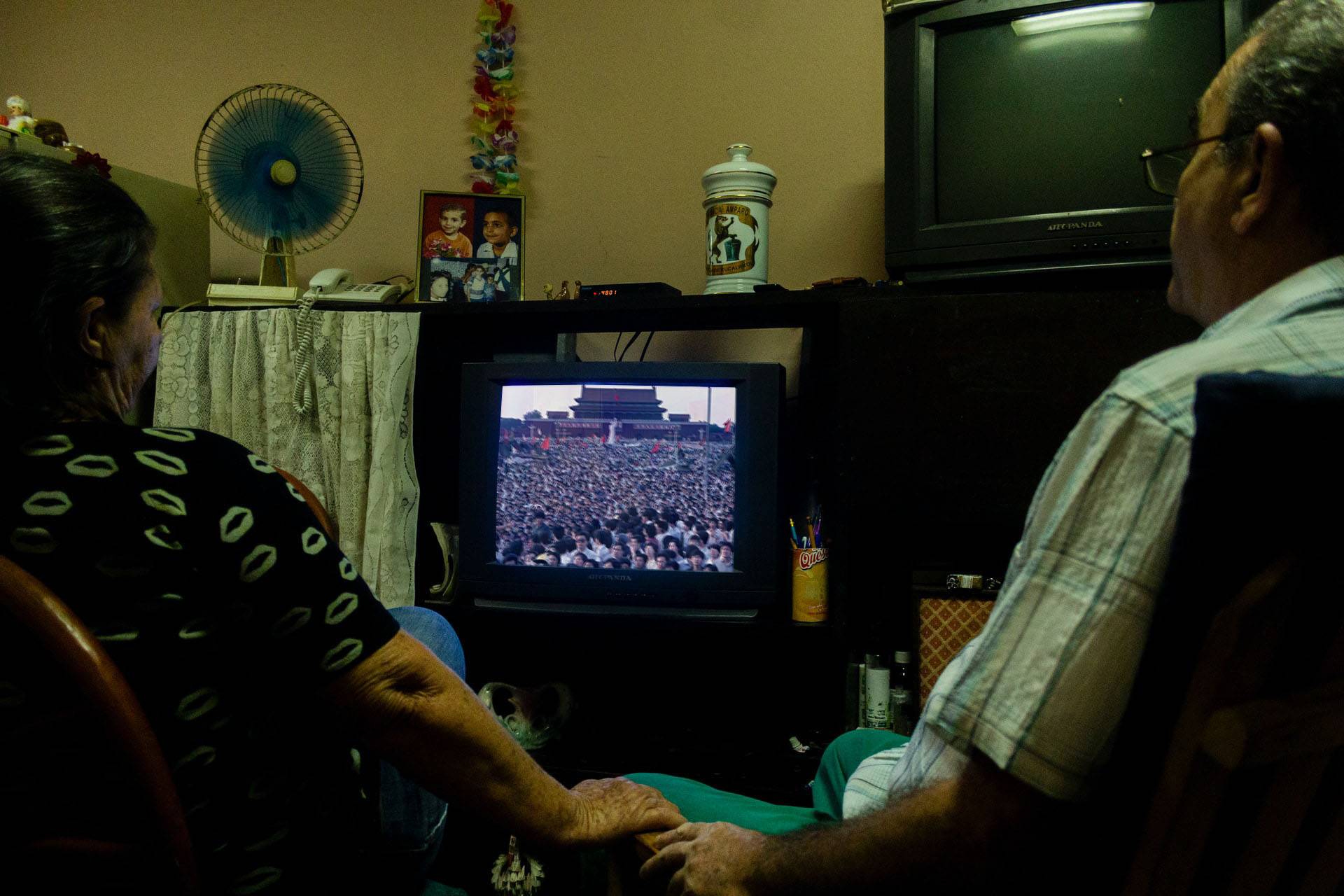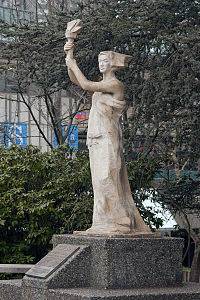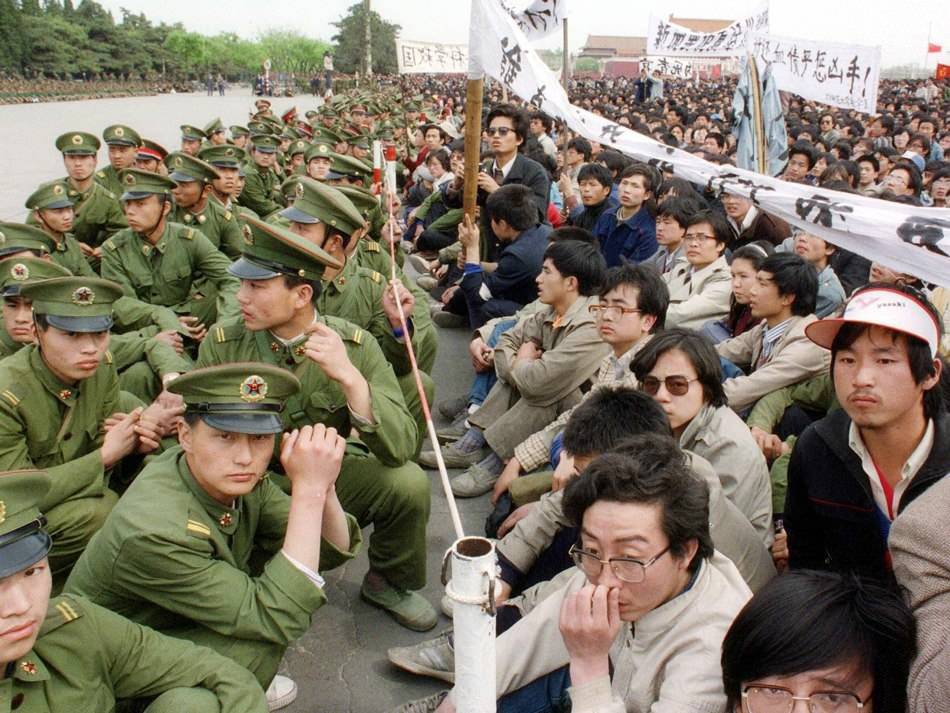THE MYTH OF THE “Tiananmen Square massacre” is arguably the most successful disinformation campaign of modern times, according to western and eastern sources—so much so that proud psychological warfare specialists recently used it to ADVERTISE their news manipulation skills. We’ll get to that below.
As everyone knows by now, there have always been two dramatically different tales about what happened in Beijing in 1989.
One is the horrific tale of the “Tiananmen Square massacre”, saying that brutal soldiers entered the public space and machine-gunned “ten thousand” peaceful student protesters calling for Western-style democracy. They pulped the bodies by running over them with tanks, before piling them up and burning them with a flamethrower. It was unspeakably horrific.
The other version says that nobody died in Tiananmen Square, although there was violence elsewhere, causing the deaths of only about 300 people, most of whom were not students but soldiers—or, to put another way, the same number of violent deaths as on any random weekend in the United States.
Me? I religiously believed the first for decades. I went to Victoria Park with my candle almost every June for 30 years.
Until I did the research and realized that almost all serious sources, western and Chinese, now support the second version—and that includes journalists and diplomats who were present, academic specialists in “human rights”, historians, and even student protest leaders themselves. Even Wikipedia now acknowledges this. It has been an astoundingly successful deception.

35 TIANANMEN FACTS YOU NEED TO KNOW
But how did the mainstream media fool us all for so long? And why do media outlets, such as the BBC, continue to mislead us? And who were the ghosts in the machine? The full story could make a stunning book. But you don’t have time for that.. To help readers make up their own minds, here are 35 facts anyone interested in the topic needs to know.
Fasten your seatbelts. We’ll go through it quickly.
1) In 1988, an office was set up in China by a relatively new organization with an innocent name – the National Endowment for Democracy.
At that time, we reporters HAD NO IDEA it was a CIA spin-off, designed to build relationships with anti-government activists overseas for the purpose of spreading disinformation and destabilising communities in the interests of the US.
2) In the following months, CIA agents helped Chinese student activists form an anti-government movement, and even provided typewriters, fax machines and other equipment to help them spread their message—this information came from a US official.


3) A key player was Colonel Robert Helvey, a 30-year Pentagon veteran of destabilization operations in Asia. He “trained, in Hong Kong, the student leaders from Beijing in mass demonstration techniques, which they were to subsequently use in the Tiananmen Square incident of June 1989,” according to a highly detailed academic paper by B. Raman, the former director of India’s foreign intelligence agency.
4) When protests broke out in China in April 1989, demonstrators were not calling for democracy, but purer socialism, free of corruption and inequality, which were endemic at the time. Students carried pictures of Chairman Mao and sang the Chinese national anthem repeatedly.
Western hybrid warfare includes two key principles:
1) Locate and amplify GENUINE local grievances, and
2) Rebrand them as calls for western liberal democracy and freedom.

5) The US State Department withdrew US ambassador Winston Lord, and replaced him with James Lilley, a veteran CIA agent who had run operations smuggling people in and out of China.
6) The Chinese protesters were advised by persons unknown to add the word “democracy” in English to their banners, and say they were calling for “freedom”, rather than their actual goal, a purer form of communism.



7) The protesters were advised to create a statue and began work on May 27. But, as good communists, students chose to make it as unlike the Statue of Liberty as possible, basing their statue (replica on the right) on the work of Russian revolutionary communist sculptor Vera Mukhina (above). The students were not at all a homogenous group, but they were socialists.
8) On May 28th, 1989, Gene Sharp, America’s top undercover street protest strategist, flew into Beijing with his assistant Bruce Jenkins to offer help. “The students in the square were operating with great commitment and bravery but they didn’t know what the hell they were doing,” Sharp later wrote.

9) As May turned into June, the energy level dropped and there was need to bring things to a head. Student leader Chai Ling gave her infamous talk, where she warned of a massacre “which would spill blood like a river through Tiananmen Square”. She added that she expected to die shortly – but confusingly also said that she no longer intended to stay in China, but wanted to move to the United States. What did that mean? It was baffling at the time, but it would all make sense later.
We now know that student leaders were promised US passports, CIA-run safe passage out of China, and enrolment in top US universities.
10) But there was a problem. Things were not coming to a head. The Chinese government was remaining remarkably restrained, as was the army. Because the main body of the protesters were asking for purer communism, people were politically on the same page – students and soldiers had good relationships, and even shared food and sang together.

Violence finally started when a mysterious group of thugs, some from ethnic minorities, triggered a fight in Muxidi, five kilometers away, attacking army buses with petrol bombs and setting them alight, burning the occupants to death. This was unexpected, because gasoline was rationed and hard for ordinary people to obtain. Soldiers who managed to escape the burning buses were beaten to death. The word “massacre” could be used for this atrocity—although that doesn’t fit the western narrative, since it was soldiers who died. Other military men arrived in Muxidi and, infuriated at the sight of their slaughtered colleagues, shot at protesters (mostly unionists rather than students): there were many more tragic deaths, this time of civilians.

11) Back in Tiananmen Square, in the early hours of June 4, soldiers arrived and called on students to leave. Student leader Feng Congde worked to gauge protesters opinions, and concluded that the majority wanted to leave. “So I announced the decision to leave,” he said. Students left peacefully.

12) At a different location on the periphery of the square, a fight broke out in which a soldier was killed, leading to some violence, according to a declassified report from the US Embassy.
13) One student protester, a friend of the present writer, watched one man lose his life. In the following skirmishes, several lives were lost. But in the square itself, the only gunfire came from bullets used to silence the sound system.
14) In contrast to this, a BBC reporter said he watched, from the Beijing Hotel, soldiers shooting at students in the center of the square. All eyewitness sources say this did not happen. It was also against the laws of physics – that location is not visible from the hotel.
“All verified eyewitness accounts say that the students who remained in the square when troops arrived were allowed to leave peacefully.”
Jay Mathews
15) Now this is where it gets strange. Over the following hours and days, a very different story was circulated, saying that the peaceful pro-democracy demonstrations in China had come to a violent and bloody end. A cable from the British Embassy said the students in the square had been massacred with machine guns, their bodies pushed into piles with bulldozers, and then incinerated by troops with flamethrowers.
16) A report was also sent out by the Australian Embassy delivering almost exactly the same information. “When all those who had not managed to get away were either dead or wounded, foot soldiers went through the square bayoneting or shooting anybody who was still alive,” said the report, read out loud by then Australian Prime Minister Bob Hawke. “They had orders that nobody in the square be spared, and children and young girls were slaughtered, anti-personnel carriers and tanks then ran backwards and forwards over the bodies of the slain until they were reduced to pulp, after which, bulldozers moved in to push the remains into piles which were then incinerated by troops with flamethrowers.”

17) An unknown (at the time) source was distributing related news “a minimum of 10,000 people had been massacred.” One document about this horrific (but fictional) massacre was sent to the Hong Kong office of the Wen Wei Po newspaper, from an anonymous source. In Beijing, a student, Wu’er Kaixi, said he could confirm that the story was true – he had watched it happen, he claimed.
18) Then came an astonishing split. The main newsrooms of the international media chose to canonize the fictional “Tiananmen Square massacre” story as fact. We ran it at great length (and came to ritually repeat it every year since). But individual reporters at the scene, often working for the same media companies, took a very different line over the days, weeks, months and years that followed.
19) The massacre story was quite wrong, said Jay Mathews, former Beijing bureau chief for the Washington Post. “A few people may have been killed by random shooting on streets near the square, but all verified eyewitness accounts say that the students who remained in the square when troops arrived were allowed to leave peacefully.”

20) New York Times reporter Nicholas Kristof, a bitter critic of China, wrote: “There is no massacre in Tiananmen Square, for example, although there is plenty of killing elsewhere.”
21) Some told the truth years later. In 2009, James Miles, a senior BBC correspondent in Beijing at the time, admitted that he had “conveyed the wrong impression” and that “there was no massacre on Tiananmen Square.”
22) Graham Earnshaw of Reuters, who was in the square, wrote a detailed report in his memoir explaining how the military came, negotiated with the students and made everyone, including himself, leave peacefully.
23) Even the student protesters debunked the story. Wu’er Kaixi, who claimed to have seen the massacre with his own eyes, wasn’t even there, they said. He had left the Square hours earlier. It was later revealed that Wu’er was a Xinjiang Uyghur named Örkesh Dölet. He was spirited out of China through the Hong Kong-based “Operation Yellowbird” and taken to the US, where he was given a place at Harvard University.
More recently, Wu’er Kaixi/ Örkesh Dölet drew parallels between the Tiananmen Square massacre and the Hong Kong 2019 riots—perhaps more accurately than he realized, both being heavily misreported using the exact same techniques, by the exact same unholy alliance of behind the scenes manipulators and anti-Chinese journalists.
24) Madrid’s ambassador to Eugenio Bregolat was filled with righteous anger. He noted that western journalists were reporting the massacre as fact from their hotel guestrooms, while Spain’s TVE channel had a television crew physically in the square that evening and knew it was false.

“Within a few days, certainly within a week, it was clear that the information about what happened in the square itself was incorrect.”
Richard Rigby
25) In fact, most diplomats knew the Tiananmen Square massacre story was fake. “Within a few days, certainly within a week, it was clear that the information about what happened in the square itself was incorrect,” Professor Richard Rigby, a staff member at the Australian Embassy in 1989, told reporters on an ABC news show.
26) US Embassy officials interviewed a Chilean diplomat who had been present in the Square at the time of the alleged massacre. He confirmed that no such thing happened. The officials kept the information secret – until it was exposed by Julian Assange’s Wikileaks operation in 2011.

27) Many diplomats strongly suspected that the Tiananmen Square fiction was “a black op”. Australia’s Professor Rigby later said: “I cannot entirely rule out the possibility that we were being fed some sort of a ‘line’.”

28) That, of course, was exactly what had happened. “The mystery report was very likely the work of the US and UK black information authorities ever keen to plant anti-Beijing stories in unsuspecting or cooperative media,” said Gregory Clark, a British-born Australian diplomat.
29) A pair of human rights campaigners, again, harsh critics of the Chinese government, were also uncompromising. In a book, George Black and Robin Munro wrote: “The phrase ‘Tiananmen Square massacre’ is now fixed firmly in the political vocabulary of the late twentieth century. Yet it is inaccurate. There was no massacre in Tiananmen Square on the night of June 3.”
30) Still, almost all the mainstream media clung tightly to their fiction. On air, Tim Russert of NBC’s Meet the Press recalled the machine gun deaths of “ten thousand students”.

31) A group called the June Fourth victims’ network decided to gather the names of the ten thousand dead for publication by a New York group called Human Rights in China. After ten years of research, the list of victims was just 155 names long, one source said. The story seems to have disappeared.
32) In 2017, diplomatic papers quietly declassified by the British government showed that it was British Ambassador Sir Alan Donald in Beijing who had spread the debunked news that that a minimum of 10,000 citizens died. The BBC and other media continues to present this as if was a credible fact from a credible source, rather than a piece of discredited fiction almost certainly from a “black op”.

33) Western publishers of many types continue to present the massacre story as fact. The Lonely Planet series, one of the world’s best-selling travel books, includes this line in its volume on China: “Eyewitness accounts have indicated that hundreds died in the square alone, and it’s likely fighting in the streets around the square led to another several thousand casualties.”
“A major lesson from all this is the need to control our Western black information operations. Few seem to realize the depth of their penetration in Western media.”
Gregory Clark
34) The “Encyclopedia of the World” (Houghton Mifflin Co, 2001) tells the children of the world, in shocked capital letters, a version of the tale even more extreme that the black op version: “June 3-4: PLA TROOPS ENTERED TIANANMEN SQUARE DURING THE NIGHT AND FIRED DIRECTLY INTO THE SLEEPING CROWD.”
35) What to do? It appears there’s nothing that can be done. Western media simply swallows disinformation about mainland China or Hong Kong and spits it out as fact, and continues to do so on a daily basis. Gregory Clark notes the incalculable harm to humanity done by “CIA/MI6 black information massacre myths and Western media gullibility”. They have prevented, and continue to prevent, any sort of accurate understanding of the recent history of the most populous community on earth.

“A major lesson from all this is the need to control our Western black information operations. Few seem to realize the depth of their penetration in Western media,” he wrote.
GHOSTS IN THE MACHINE
Now there are going to be some people who will not accept that the story we so long believed, that peaceful pro-democracy demonstrations in China came to a violent and bloody end, was a “psy-ops” operation by US disinformation specialists.
To those people, I would point to a recruitment video by US military disinformation specialists released this year. It aims to introduce viewers to the world of international disinformation techniques. Called Ghosts in the Machine, it begins with black and white cartoonish images and words, and then we hear a newscaster speaking the following sentence:
“As the world watches and listens in horror, the peaceful pro-democracy demonstrations in China come to a violent and bloody end.”

The video proceeds with a collage of scenes from different civil unrest events around the world with which NED and other US agencies have been involved (including the Hong Kong protests of 2019), and ends with an invitation for viewers to join the masters of information warfare.
“Have you ever wondered who’s pulling the strings?” it asks. “You’ll find us in the shadows,” it continues.
“Warfare is evolving. And all the world’s a stage.”
“Everything we touch is a weapon.”
The disinformation specialists are genuinely proud of what they do. And, if we set questions of morality aside, we can see that they deserve to be proud. They fool people.
FACTS DON’T MATTER
Let’s give the last word to Hou Dejian, a Taiwan-born singer-songwriter, who left the square peacefully with other protesters on June 4, 1989. He is a passionate critic of the Chinese government, yet was even more horrified at the lies of the western media, inventing an entire massacre that never happened.
“I myself was in the Square until six thirty in the morning,” he said. “I kept thinking, are we going to use lies to attack an enemy who lies? Aren’t facts powerful enough?”
Facts? The answer to Hou Dejian’s question, sadly, is no: in the political sphere, disinformation is more powerful. Media distortion is the weapon that brings power, and words like freedom, democracy and human rights are simply bullets to be fired.
Colonel Bob Helvey used to recall how his friend and colleague Gene Sharp, master of media manipulation, used to begin his talks: “My name is Gene Sharp, and we’re here today to discuss how to seize political power and deny it to others.”
Image at the top from Jan Antonin Kolar/ Unsplash
